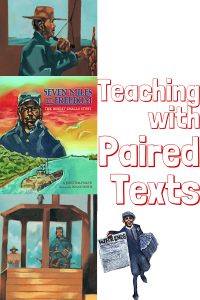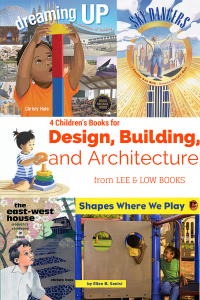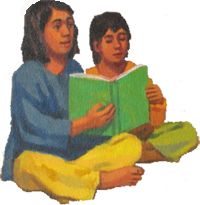National Adoption Day this November 22 and National Adoption Month this November afford a time to share experiences and reflect on families. Whether you have students who have been adopted or are part of a family considering adopting a child into your home, all children can benefit from learning about adoption. Children are very curious about each other’s families, quick to categorize into groups, and intent to define what makes a family, well, a family. Continue reading
All posts by jilleisenberg14
First Look, Second Look, Third Look: Close “Reading” with Book Art
I’ll admit it: I was looking for a Native American book by a Native American author to write about in light of Thanksgiving and National American Indian Heritage Month as many teachers do this time of year. Continue reading
Reading Paired Texts to Increase Student Engagement
In the fall of 2012 a news story emerged that astronomers had discovered a planet largely made out of diamond. Third grade at my school spent the first two quarters studying the solar system; therefore, this news was received with irrepressible glee in my classroom. Although the media nickname “Lucy” was lost on my students (as in the Beatles’ “Lucy in the Sky with Diamonds”), the wonderment and rejuvenated commitment to the content were obvious.
Seeing that scientists were still studying and discovering facts about our solar system and distant others was exciting to my students and made them feel like they were on the frontier learning alongside real astronomers. Pairing the news article with The Magic School Bus: Lost in the Solar System spurred very creative journal entries throughout the unit, including envisioned future discoveries of all sorts of substances for planets: kitten fur, gold, bubbles.
Incorporating current events and news stories into the classroom can engage students with a renewed sense of purpose and interest. Pairing a news article with a book on a similar topic or theme offers students greater context and a sense of relevancy for the content they are learning, and perhaps a jolt to the creeping apathy over a curriculum students had little input in selecting.
 So, what does it look like to use paired texts in the classroom?
So, what does it look like to use paired texts in the classroom?
How to Teach Close Reading Using a Recipe
What happens if we don’t follow a recipe? Potentially, a disaster. Recipes require careful reading and we can literally taste the consequences of our failure to do so. In this way, a recipe is fantastic for small group instruction, such as guided reading, and for parent-child practice because it is grounded in real world applications and requires multiple re-readings to grasp the information.
For guided reading, there were only a dozen or so book sets that I used with my students because those available to me were dated in content (think: Pluto is still a planet) and image, worn out from being shared across the whole school, and unreliable in student engagement. On one of my monthly trips to a Friends of the Library book sale, where I often scrounged, hunted, and bargained, I discovered a milk crate full of the children’s literary magazine, Cricket. As these were used periodicals, they were available for free. I remember the award-winning magazine as a child myself and quickly discovered that the wide variety of high-quality texts would be perfect for guided reading, including the recipes and craft instructions.
 Young readers can use recipes to analyze an author’s choices, such as the order of steps, choice of ingredients, and ingredient amounts. Recipes provide hands-on experience at home while building critical background schema and additional practice with a nonfiction text. Recipes are great for teaching close reading because they:
Young readers can use recipes to analyze an author’s choices, such as the order of steps, choice of ingredients, and ingredient amounts. Recipes provide hands-on experience at home while building critical background schema and additional practice with a nonfiction text. Recipes are great for teaching close reading because they:
- naturally engage students with the content (yum!)
- create real-world connections for why we learn to read and the skill of close reading (look—even adults do it!)
Inspiring the Next Architects: Children’s Books About Design, Building, and Architecture
Celebrate architecture and design for Archtober with students!
October, or “Archtober” as it is called, marks the 4th annual month-long festival of all things architecture and design in New York City.
 Recommended reading to teach about architecture for students:
Recommended reading to teach about architecture for students:
5 Strategies to Help Parents Navigate Lexile
 This week we are tackling what parents can do once they hear those magical words, “Your child has a Lexile score of…” For strategies for teachers and booksellers on navigating leveling systems and building a community, check out here and here.
This week we are tackling what parents can do once they hear those magical words, “Your child has a Lexile score of…” For strategies for teachers and booksellers on navigating leveling systems and building a community, check out here and here.
For parents who want to help your children find a book at their levels:
1. Ask teachers what leveling system they are using to assess your child’s reading growth.
- What does this system measure?
- What does a book at this level look like? Below-level book? Above-level book?
- What are examples of books and series that are on this level?
- Where can I find out more information about this leveling system and books measured using it?
 2. Research books and this leveling system for yourself online. Publishers and the leveling systems themselves often have books leveled. Additionally, there are many booklists already out there. Remember, your child isn’t the only one to ever have achieved a Lexile level 620. Someone has made a list before you.
2. Research books and this leveling system for yourself online. Publishers and the leveling systems themselves often have books leveled. Additionally, there are many booklists already out there. Remember, your child isn’t the only one to ever have achieved a Lexile level 620. Someone has made a list before you.
- For pre-made lists: Literacy organizations, such as Reading Rockets, ReadWorks.org, and Reading is Fundamental, have created top-notch reading lists. Libraries, such as Phoenix Public Library who built its own reader’s service to search titles by Lexile, often have ready-made booklists by grade and theme.
8 Strategies to Help Educators Explain Lexile and Invest Stakeholders
What happens when there is a lack of or break down in communication between stakeholders about the tools used to assess children’s reading? One bookseller shared her experience when parents, booksellers, and students attempt to find the right book within a leveling framework.
In our previous post, “7 Strategies to Help Booksellers and Librarians Navigate Lexile,” we presented strategies for the book experts out in the field on strengthening the communication lines, sharing resources and context, and building a community invested in each child’s education. In doing so, we show our students, children, and customers that they have a whole team cheering for them and invested in their growth, joy, and success.
Now for educators! Want a child to achieve a year and a half of reading progress and develop a lifelong passion for learning? The more adults you have involved in your students’ success, the better chances you have for meaningful growth and creating a love of reading.
For teachers and school staff who want to invest more stakeholders:
1. Don’t wait for summer break to provide reading lists. After each assessment cycle or parent-teacher conference period, provide parents with book ideas to help students get to the next level. Research or create booklists to hand parents at a parent-teacher conference. Except for the outliers, you can generally get away with making 3 lists (above-, on-, and below-grade level) of where students are reading.
-
- For pre-made lists: Literacy organizations, such as Reading Rockets and Reading is Fundamental, have created top-notch reading lists. Libraries, such as Phoenix Public Library who built its own reader’s service to search titles by Lexile, often have ready-made booklists by grade and theme and may subscribe to NoveList K–8 Plus.
7 Strategies to Help Booksellers and Librarians Navigate Lexile
 I highly recommend all educators and parents read a bookseller’s perspective on leveling systems, Lexile in this case, which we re-posted on our blog last week. There are great firsthand examples of parents and booksellers striving in earnest to help children improve in reading.
I highly recommend all educators and parents read a bookseller’s perspective on leveling systems, Lexile in this case, which we re-posted on our blog last week. There are great firsthand examples of parents and booksellers striving in earnest to help children improve in reading.
Regardless of where one comes down on leveling books and assessing students with leveling systems, last week’s post laid bare the lack of or breakdown in communication between all stakeholders about the tools used to assess children’s reading growth.
Whether a child’s reading abilities are measured using Lexile, Accelerated Reader, DRA or another, we must equip any and all stakeholders in a child’s education with knowledge about what these tools mean and concrete ways to further support the child.
Children spend 7,800 hours outside of school each year compared to 900 hours in school. The National Center for Families Learning asserts that “the family unit—no matter the composition—is the one constant across the educational spectrum.” I am extending the definition of a child’s family to include afterschool volunteers, librarians, booksellers, pediatricians, and anyone else involved in a child’s education journey.
 Below are strategies for strengthening the communication lines, sharing resources and context, and building a community invested in each child’s education. In doing so, we show our students, children, and customers that they have a whole team cheering for them and invested in their growth, joy, and success.
Below are strategies for strengthening the communication lines, sharing resources and context, and building a community invested in each child’s education. In doing so, we show our students, children, and customers that they have a whole team cheering for them and invested in their growth, joy, and success.
Character Education, Part 2: How to Teach Core Values To Kids Meaningfully
 Last week, we looked at how to pick significant books to teach the core values that will guide our classrooms and school communities for the coming year.
Last week, we looked at how to pick significant books to teach the core values that will guide our classrooms and school communities for the coming year.
In addition to having the right books with fitting characters and messages, we need to embed these core values in additional activities in the coming first weeks or months of school.
There are three rules in teaching students about core values: model, model, model. Students must see core values in practice in order to grasp abstract concepts such as empathy, persistence, or pride. Below are a sample of ways to integrate core values into character education and ELA instruction.
1. Extend a fiction or nonfiction book’s message of characters struggling with the core value beyond the text.
-Ask questions during and after the reading: How does this character demonstrate respect? Or, how does this character struggle with respect? (look at the character’s actions, feelings, opinions about and interactions with other characters, and dialogue) What advice would you give this character? How should this character handle the situation next time?
-Have students in small groups act out how they would have handled the situation in the book differently or give advice to the main character(s).
-Invite students to create a job ad looking for a person that demonstrates the selected core value. On the flip side, have students create a “Wanted” poster of a character not demonstrating the core value and describing the character.
-Turn the book into a Reader’s Theater script so students can perform it to younger grades and lead a discussion on why this book is good for learning about the particular core value.
Character Education, Part 1: How To Choose Books For Core Value Study
 As we cluster in workshops, around webinars, and near the water cooler, we are already thinking about and preparing what skills and knowledge we want to teach. Yet, to truly have a successful year, let’s ponder an additional question: who do we want to teach?
As we cluster in workshops, around webinars, and near the water cooler, we are already thinking about and preparing what skills and knowledge we want to teach. Yet, to truly have a successful year, let’s ponder an additional question: who do we want to teach?
The start of school is a popular time to model and instill core values because August and September are a fresh start: our time as teachers, librarians, and administrators to create and cultivate a community bound and motivated by the same values and goals. It is during this period that we can expose our students to stories with strong morals that feature both examples and non-examples of how to react in tough situations and learn from one’s mistakes.
However, it can be very difficult to select just the right text to teach values that will guide our students through academic and developmental challenges over the coming year and lay the groundwork for the community we hope to build.
Many teachers dust off their tried-and-true character education read alouds each coming school year or rely on word of mouth recommendations that send us back to the classics year in, year out. During my first year of teaching, I remember everyone scrambling to find a book that demonstrated “respect” or “persistence.” When a master teacher on campus mentioned that she used a particular title for the start of every first week of school, that sounded like hard proof to me and I was grateful. I went out and bought it.
Yet, there is not just one book that will make the abstract concept of “empathy” or “leadership” concrete to third graders or kindergartners. With such dependence on the same books, many of my third graders had read The Lorax three years in a row to learn about responsibility and respect. It’s an outstanding book to explore these values, but still…three years? It was time to shake things up.



